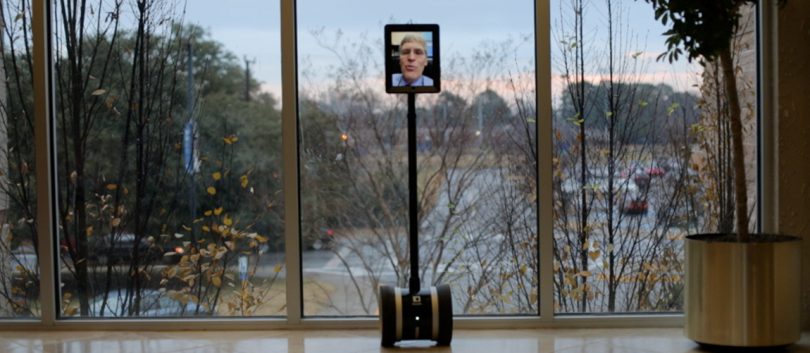Silently, it wheels down the hall, hardly making even a hum in the quiet hospital corridor.
“Dr. Lancey, you’re going to hit the wall,” warns nurse Michelle Sims as she glances up from a nurses’ station at the Bon Secours Maryview Medical Center in Portsmouth, Virginia.
Bump.
Dr. Robert Lancey—that is, the robot Dr. Lancey—sideswipes the wall, recovers, then smoothly cruises by the nurses to say hello before heading back to the real Dr. Lancey’s office.
“Shut up,” comments visiting family member Chelse Brown, catching sight of the robot while coming out of her mother’s hospital room. “That’s a doctor? Oh, my gosh. That’s so cool.”
Meet the “other” Dr. Lancey—a sleek, 15-pound robot that’s really an iPad attached to self-balancing, motorized wheels. (Think of a cross between a Segway and an iPad.) It’s one of the latest advancements in today’s technology fueled world that allows people to have a telepresence without actually being there.
Using his own iPhone, Lancey can control the robot, maneuvering it around the hospital to visit patients. And it doesn’t matter where he is when he’s using it. He can be at home, or in his office.
The robot being used at Bon Secours is by California-based Double Robotics, which launched the device in 2013. Popular with telecommuters, the robots have been slowly finding their way into hospitals, allowing doctors an opportunity to “visit” with their patients more frequently than their physical presence might allow.
Another telemedicine robot on the market—RP-VITA—is made by the same company that makes Roomba vacuum cleaners.
The Heart & Vascular Institute at Maryview Medicial Center in Portsmouth, where Lancey is a cardiothoracic surgeon, acquired the robot last summer. There’s also one at Bon Secours’ hospitals in Newport News—Mary Immaculate—and Richmond—St. Mary’s. Bon Secours hopes to eventually bring the robots to all its seven hospitals in Virginia.
Lancey admits he was at first hesitant to use the robot since he prefers to be very hands-on in the care he gives his patients. Then, he says, he realized using the robot allowed him to simply supplement his care. And he hasn’t had a patient who hasn’t gotten a grin on his face at the sight of it.
“It gives them a degree of confidence that we’re here,” he says. Cardiothoracic patients need frequent monitoring once they come out of surgery. Lancey finds the robot useful if he wants to check in on a patient late at night, or do an extra check once he’s already gone home. Using the controls on his iPhone, Lancey can angle the iPad to look at the patient’s face, checking his color in real time. He can ask a nurse to go over vital statistics, or to hold up an EKG for him to see.
Lancey also found the robot came in handy recently when he had a cold and didn’t want to get too close to his patients. He used the robot to make his rounds, standing in the hallway while controlling the device.
Hampton resident Ronald Lewis was in his hospital bed in December, recovering from having an aortic heart valve replaced, when an iPad on a stick came rolling through his door.
“It was a strange sight when it came through,” says Lewis, who is 66. “I realized Dr. Lancey’s face was in it. I thought, ‘Isn’t this a trip!’ He was just checking up on me to make sure I was OK.”
Lewis says he was impressed by the robot and how Lancey is using it with his patients.
“It’s a great idea,” Lewis says. “It gives you that almost personal touch, without him being there. You had direct communication face to face, without being right there.”
So far, the hospital’s robot doesn’t have a nickname, although Lancey has been encouraged to name it.
“It’s mostly called, ‘Oooh!’ ” he jokes.

